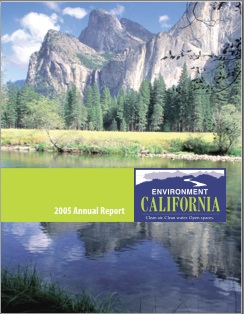 One of the groups I support and learn from is Environment California who have been great advocates of AB 811 and AB 920, the one-two punch for solar we absolutely need to drive solar sales at the rate demanded by today’s CO2 levels. Dan Jacobson is the Legislative Director of Environment California and he’s both progressive and effective – and someone I admire a great deal.
One of the groups I support and learn from is Environment California who have been great advocates of AB 811 and AB 920, the one-two punch for solar we absolutely need to drive solar sales at the rate demanded by today’s CO2 levels. Dan Jacobson is the Legislative Director of Environment California and he’s both progressive and effective – and someone I admire a great deal.
Dan’s been a big help to California Assemblyman Jared Huffman’s efforts to get AB 920 turned into the feed-in tariff law that will drive sales of solar literally through and onto every available rooftop in the Golden State. And if you talked with Lawrence Cooper he’d probably tell you it would be a big help in getting to 33% renewable energy in California. Lawrence Cooper works with Assemblyman Huffman, and AB 920 is one of his big responsibilities.
I heard from Cooper a couple of times this week with updates on the progress of AB 920 which is expected to be heard on Monday in Senate Appropriations, where it will be referred to the suspense file due to the cost. Cooper and his team will then start to work to get the bill out of suspense.
Cooper has already worked long and hard, including setting me straight about SCE’s support for the bill. I had gotten that wrong in my piece on Monday and Cooper was kind enough to correct me without beating me up.
Cooper also taught me that any bill with a cost impact to the state (in this case a cost of $250,000) is placed on the suspense file. It’s very common. In fact, when AB 920 went through the Assembly Appropriations Committee it was placed on suspense before being voted out.
Luckily for AB 920, the costs come out of a special fund for the Public Utilities Comission, not the state’s general fund (which funds education, healthcare etc) so the impact isn’t as great. And the costs are fairly modest – especially when you consider the gigantic payback and the urgent need. So in a reality based world the bill doesn’t look costly at all.
 Finally, while it’s certainly no guarantee, the chair of the Californian Senate Appropriations Committee did vote for the bill in the policy committee, so Cooper still likes his chances on AB 920, but we still need to call our state senator’s office to make sure it happens.
Finally, while it’s certainly no guarantee, the chair of the Californian Senate Appropriations Committee did vote for the bill in the policy committee, so Cooper still likes his chances on AB 920, but we still need to call our state senator’s office to make sure it happens.
You’d think it would be a no-brainer with our Renewable Portfolio Standard requiring electric companies to offer 20% of all electricity to be generated from renewable sources. But setting a standard ain’t the same thing as keeping a standard.
Established in 2002 under Senate Bill 1078 and accelerated in 2006 under Senate Bill 107, California’s Renewables Portfolio Standard (RPS) is one of the most ambitious renewable energy standards in the country. But without execution ambition is empty.
The RPS program requires electric corporations to increase procurement from eligible renewable energy resources by at least 1% of their retail sales annually, until they reach 20% by 2010 and to 33% by 2020. But it doens’t penalize them or punish them in any way if they don’t meet the requirement.
That’s why Dan Jacobson and others, including your Creative Greenius, want to see the 33% standard made into more than just a goal to be aimed at and missed – like the 20% goal we’re supposed to meet next year in 2010 and won’t be close to meeting. Or the million solar roofs goal which apparently is just a marketing gimmick with no tooth, gums or even a mouth to back it up. Why not just call it the trillion roof goal?
I got an email from Dan Jacobson today about the new bill that would turn that goal into a real law that must be obeyed. And the Greenius sez that unless you give it the force of law then the utilities won’t do it. But don’t just listen to me, here’s what Dan has to say about it:
There is important legislation right now before lawmakers in Sacramento to triple the amount of clean energy we produce as a state, taking us from generating 11% of energy from renewable sources to 33% clean energy.
I wanted to share this message from Brian Hurd, a solar installation instructor and president of Hands on Solar, Inc., who started the first program in the state for inner city students. He also conducts workshops for teachers from all around California on how to start effective programs in solar electricity.
Dan Jacobson
Legislative Director, Environment California
 Hello Environment California members,
Hello Environment California members,
Over the past several years, I have been teaching photovoltaics (solar electricity) to inner city students. We cover solar technology in depth, how it works and how to install these state-of-the-art electrical systems on our homes and businesses.
Whether I am teaching other teachers or inner city youth, students are in my classes because they get it. Green energy technology is the wave of the future — and the way to rebuild our economy is to start with clean energy. But we can’t create a green economy on wishes alone. Jobs have to be created.
If we triple our goals for clean energy production that will mean utilities will start building more windmills, you’ll see more solar panels on schools and government buildings, and you’ll see an emerging market for new high-tech green jobs.
How did FDR end the Great Depression? He created jobs.
I teach some of the brightest and most enthusiastic students who want nothing more than to repower this state with green energy. But it takes more than rhetoric. It takes a commitment from our leaders in Sacramento.
It’s time to triple our clean energy use. Tell your legislators to act:
http://www.environmentcalifornia.org/action/energy/it-time-to-triple-it?id4=ES
Thanks,

Brian Hurd
President, Hands On Solar, Inc.
http://handsonsolar.org/


I’ve seen a few arguments put forth on why a Feed In Tariff might not work. Can you help me counter these arguments?
1. A FIT does not take account of time-of-use. Electricity is more valuable during peak afternoon demand.
2. A FIT does not take account of location. Some utilities are generating more expensive or more environmentally damaging power.
3. A statewide FIT is horrendously complicated to implement in California’s complex utilities market.
4. A FIT does not address energy efficiency. This argument is only relevant if the FIT takes up too much mindspace compared to AB811 etc.
Thanks for your help.
From the Greenius:
Richard, first off when you write about “A FIT” that implies that there’s one flavor and execution of Feed In Tariffs to choose from. So for example, your first question stating that “A FIT” doesn’t take into account time of use, I have to ask, who says it doesn’t? Which FIT program are you talking about? Because there’s no reason a feed in tariff couldn’t be based on Time of Use.
Secondly, there’s also no reason an FIT can’t take into account where you live. Your electric rates already take into account where you live and who you buy your power from. So does the solar rebate program.
Thirdly, there’s no evidence or logical reason to think that a FIT is too complicated to implement in the California market. The Solar rebate program hasn’t proven to be too complicated and it deals with the very same market.
Finally a FIT does indeed address energy efficiency because if I have a solar system and I’m getting a FIT for it then I have an incentive to use as little power as possible to make the most profit from the FIT.
Is there any further update on AB 920? They put off the crucial pricing decision twice, I see. One article implied that they will opt for 5cents a kwh or less, which would, imho, pretty well gut the bill, only slightly reimbursing those who were previously heedlessly giving the utility a free surplus, but not providing any incentive to add more capacity beyond that needed to get you out of the higher rate tiers. I have a great location for solar and would like to add as much as will fit, but am not interested in giving it away to PG&E. The rate should be set at least at the cost of financing more capacity to encourage increased installation across the state.
Hi Jeff,
I do not have high hopes (or any hope actually ) for AB 920 which didn’t turn out to be anything like the feed-in tariff we really need for solar to take off in California. I was naive and wrong to promote it as I did in 2009.
The only recent update I’ve seen is:
http://solarhbj.com/news/california-solar-owners-to-start-receiving-payment-for-surplus-generation-01245
which as you mentioned pegs the likely pricing at 5 cents a kwh. I agree with you that that rate would be meaningless and do nothing to prompt people to to install as much solar as viable for their location. Clearly the utilities have no interest in seeing individuals max out their solar potential on their homes or businesses.